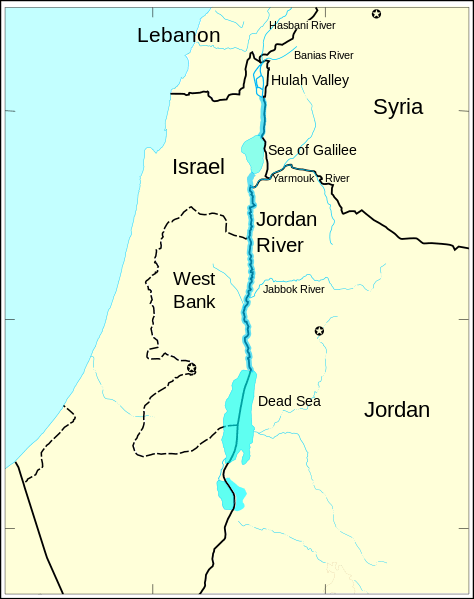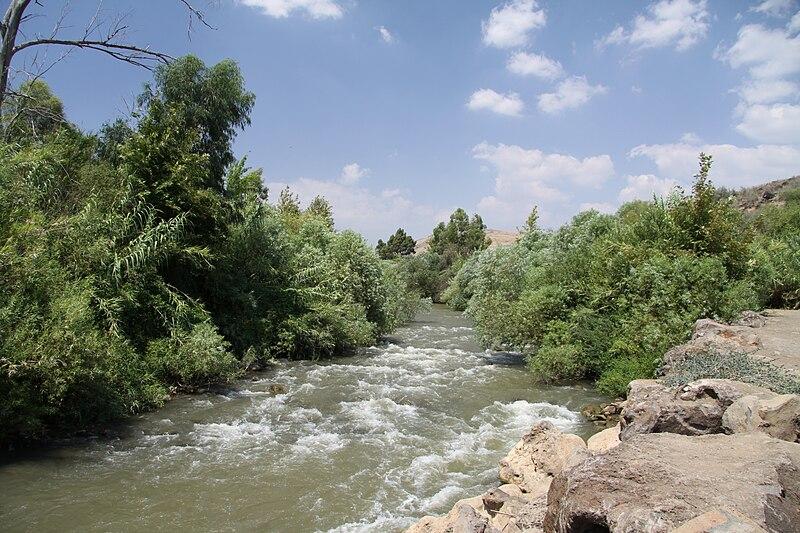The Baptism of Jesus
13 Then Jesus came from Galilee to John at the Jordan, to be baptised by him. 14 John would have prevented him, saying, “I need to be baptised by you, and do you come to me?” 15 But Jesus answered him, “Let it be so now, for it is proper for us in this way to fulfill all righteousness.” Then he consented. 16 And when Jesus had been baptised, just as he came up from the water, suddenly the heavens were opened to him and he saw God’s Spirit descending like a dove and alighting on him. 17 And a voice from the heavens said, “This is my Son, the Beloved, with whom I am well pleased.”
New Revised Standard Version Bible: Catholic Edition, copyright © 1989, 1993 the Division of Christian Education of the National Council of the Churches of Christ in the United States of America. Used by permission. All rights reserved.
What to do with this educator’s commentary
This commentary invites you as a teacher to engage with and interpret the passage. Allow the text to speak first. The commentary suggests that you ask yourself various questions that will aid your interpretation. They will help you answer for yourself the question in the last words of the text: ‘what does this mean?’
This educator’s commentary is not a ‘finished package’. It is for your engagement with the text. You then go on to plan how you enable your students to work with the text.
Both you and your students are the agents of interpretation. The ‘Worlds of the Text’ offer a structure, a conversation between the worlds of the author and the setting of the text; the world of the text; and the world of the reader. In your personal reflection and in your teaching all three worlds should be integrated as they rely on each other.
In your teaching you are encouraged to ask your students to engage with the text in a dialogical way, to explore and interpret it, to share their own interpretation and to listen to that of others before they engage with the way the text might relate to a topic or unit of work being studied.
Structure of the commentary:
The world of the Matthew’s community
Text & textual features
Characters & setting
Ideas / phrases / concepts
Questions for the teacher
The world in front of the text
Questions for the teacher
Meaning for today / challenges
Church interpretations & usage
The World Behind the Text
See general introduction to Matthew.
The world of the text
Text & textual features
This scripture story is a narrative evident in the structure: beginning middle and end, with a problem in the middle. The three Synoptic Gospels include this story – Mt 3:13-17; Mk 1:9-11 and Lk 3:21-22. Matthew expands on Mark’s Gospel with some unique inclusions. While not including this exact story, the Gospel of John references John the Baptist performing baptisms in the Jordan (1:19-34).
The Synoptic Gospels tell the story how Jesus travels from Galilee to the Jordan River in the desert to be baptised by John. In this single event, the person and mission of Jesus is revealed. This event is not a spectacle for the crowd but rather a unique spiritual experience for Jesus. While the Gospels do not state how Jesus experienced this event, they draw upon some powerful Old Testament images to illustrate the great significance of this event for him. From this moment on, Jesus presents himself to people as the one sent by God, charged with the messianic mission, who importantly, reveals God through his actions and words.
The Old Testament imagery used in this Gospel would be clearly understood by Matthew’s audience who were mainly Jewish. These powerful images include:
- V16 The ‘opening of the heavens’ recalls Isaiah 64:1.
- V16 ‘God’s Spirit descending like a dove’ recalls the creation story in Genesis 1:2.
- V17 ‘Beloved’ evokes Gen 22:2 and the story of Isaac, specifically the words spoken by God to Abraham when it appeared God was calling for the sacrifice of his son.
- V17 ‘In whom I am well pleased’ evokes Isaiah 42:1-4. This passage from Isaiah was used to describe the intimacy of Jesus’ communion with God.
- V17 ‘This is my Son the Beloved, with whom I am well pleased’ recalls the words of Psalm 2.7 which was used in the consecration of the King.
Characters & setting

The Jordan River runs from the north to the south through Israel and the Palestinian territories. It begins north of the Sea of Galilee and flows south to the Dead Sea. The Jordan River forms a boundary between Israel and Jordan.
The Jordan River holds much importance for the Jews as Joshua led the tribes of Israel through the Jordan River into the Promised Land after wandering in the desert for many years (Joshua 3:1-17).
It required a significant commitment by someone in order to listen to John the Baptist preach and be baptised by him. It was a difficult and perilous journey to undertake as they travelled from their home towns into the desert to meet John the Baptist.
Galilee: Galilee was one of the three regions of the Holy Land during the time of the Roman rule. Galilee was the northern region including the towns of Nazareth, Capernaum, Cana, and Gennesaret. It was the focus for much of Jesus’ ministry.

John the Baptist: was a Jewish religious preacher who was portrayed as an Old Testament prophet. Baptist comes from the Greek word meaning ‘dip’ or ‘immerse.’ He is featured in all four gospels. John worked on the margin out in the Judean desert and he attracted many people. People journeyed away from Jerusalem (where the Temple is located and considered the religious centre of Israel) into the desert to hear his message. Like Jesus, John is presented by Matthew as announcing the imminent coming of the Kingdom of Heaven.
John’s message was stark as he believed that the social and religious structures of his time did not reflect the values and ways of the Kingdom of Heaven. John’s message was calling on people to change their heart in response to the imminence of the Kingdom of Heaven. Israel’s reality as a covenant people had to be rediscovered. Being baptised by John was an external expression of people’s desire to change and live as a covenantal people again.
Jesus: This baptism was a turning point for Jesus as he is identified as both the Messiah and as the Son of God. Jesus is created anew and commissioned to fulfil God’s mission which is to preach, teach, heal and challenge the oppressors of the poor. By submitting to John’s baptism, Jesus is doing want God wants and ‘fulfills all righteousness’ (v 15).
The dialogue (v 14-15) between Jesus and John is unique to Matthew’s Gospel. The dialogue indicates that John is aware of Jesus’ superiority as the mightier one who will baptise with the Holy Spirit (v 11). Even though John objects, Jesus insists that John baptise him. This act demonstrates Jesus’ identification with sinners which will become an important theme in Matthew’s Gospel.
Ideas/phrases/concepts
Righteousness: This is a Jewish term that is important in Matthew’s Gospel. In the biblical tradition, righteousness referred to the covenantal relationship between Israel and God. The covenant sets out how the Israelites were to live out the covenantal requirements in everyday life. A righteous person was one who kept the Torah not only legalistically but also as practical expressions of ‘doing what God wants.’ Claiming one was descended from Abraham and, therefore, belonging to God’s people, was not sufficient for John. He believed that one must do want God wants and live according to the requirements of the convent.
Baptism: John was not a Christian and the baptism he offered is not the same as the later Christian ritual of Initiation (Sacrament of Baptism). Some theologians believe it was a variation on a Jewish practice at the time which involved the immersion into water to achieve ritual purification. Therefore, baptism was an outward sign of repentance and it could be repeated.
Kingdom of Heaven: is the preferred term used by Matthew for the ‘kingdom of God’ or the ‘rule of God.’ This term was used to represent a state of affairs rather than any institution or place. John considered the present social and religious structures were not reflecting the values proper to the Kingdom of Heaven.
At this time, there was a belief that the world as it was known, was in the grip of Satan. This captivity was manifested through poverty, sickness, disease, the Roman occupation, the tyranny of local rulers, heavy taxation and debts. John’s call for repentance was not just for the forgiveness of sins but also for a radical and deep-seated change of the state of affairs. He challenged the nation as a whole to transform societal relationships, values and lifestyles in order to better reflect those of the Kingdom of Heaven.
Holy Spirit: The Spirit that brought about Jesus’ conception was now commissioning Jesus to bring about God’s dream for the world. Jesus’ Spirit empowered mission will reclaim human lives for a new humanity.
Questions for the teacher:
The world in front of the text
Questions for the teacher:
Please reflect on these questions before reading this section and then use the material below to enrich your responsiveness to the text.
Meaning for today/challenges
This feast provides the opportunity to reflect upon one’s own baptism. The Sacrament of Baptism is sometimes understood as a one-time event, imposed by parents on their children, to remove original sin and to make them a child of God.
A more contemporary understanding of Baptism is not to think of it as an isolated event but rather as something that continuously takes place within the context of everyday life. Baptism is God’s gift of gracious love and a response to this gift is to go out to others in a mission of love. The Baptismal ritual is just the beginning of the process of growing into the Body of Christ. Each person is called to be a living witness to the Gospel in their everyday life. Baptism does not make one a messiah for the world but rather each person is ‘missioned’ to make a difference in their own part of the world. Christians, being inspired by the vision of Jesus, are called to build a world based on love and justice, where human dignity is respected and affirmed, and people live in right relationships with each other.
Church interpretation & usage
A common question asked about this passage is why did Jesus undergo baptism with John?
Firstly, the people baptised by John did so because it was an external sign of their repentance and their desire to change their heart and to live according to the covenant. Jesus was not baptised because he identified with them as a sinner but rather he identified with the crowd as a fellow human being and in doing so, he expressed his total solidarity with the human race. Through this identification, he may have felt the burden of the pain and suffering people were experiencing as a result of the current state of affairs. This theme of Jesus identifying with the sinner is found throughout Matthew’s Gospel.
Secondly, it is important to emphasise a key element of this story which is that Jesus is accepted and confirmed by God. Jesus is being ‘missioned’ by his Father for the work he is just about to begin. This work includes teaching, healing and liberating those suffering oppression. This element is far more important than limiting this event to just being about sinfulness.
Liturgical Use
In the liturgical calendar, the Feast of the Baptism of the Lord signifies the end of the Christmas season and the beginning of Jesus’ ministry. Specifically, this text (Mt 3:13-17) is the Gospel for the feast of the Baptism of the Lord during Year A.
